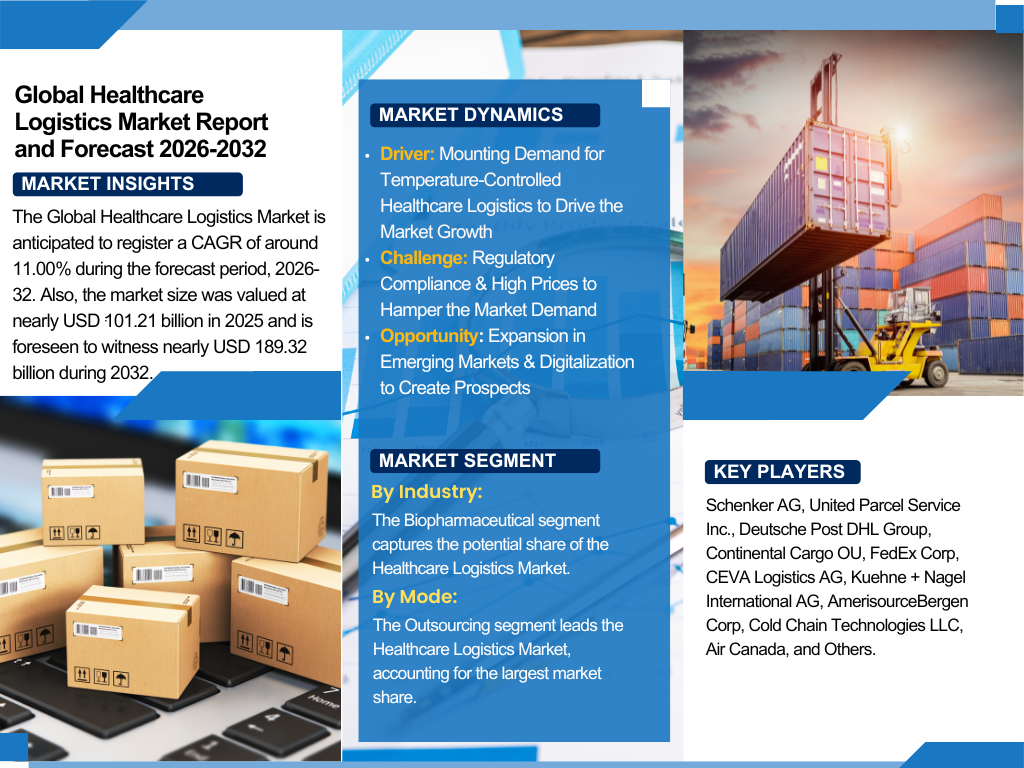Introduction
The healthcare logistics market plays a crucial role in ensuring the safe and efficient transportation of medical supplies, pharmaceuticals, and healthcare equipment. With the increasing demand for healthcare services, advancements in medical technology, and the growing need for temperature-sensitive drug transportation, the healthcare logistics sector has become a vital part of the global healthcare industry.
According to a study published by The Report Cube, the Global Healthcare Logistics Market was valued at USD 101.21 billion in 2025 and is projected to reach USD 189.32 billion by 2032, growing at a CAGR of 11.00% from 2026 to 2032. This significant growth highlights the increasing importance of logistics in healthcare delivery.
What is Healthcare Logistics?
Healthcare logistics involves the storage, transportation, and distribution of medical goods such as:
- Pharmaceuticals (medicines, vaccines, biologics)
- Medical devices (surgical instruments, diagnostic equipment)
- Healthcare supplies (gloves, masks, syringes)
- Temperature-sensitive products (vaccines, biologics requiring cold chain logistics)
Efficient logistics ensure that these products reach hospitals, clinics, pharmacies, and patients safely, on time, and in optimal condition.
Key Factors Driving the Healthcare Logistics Market Growth
- Rising Demand for Pharmaceuticals and Biologics
The increasing prevalence of chronic diseases, aging populations, and the need for specialty drugs have boosted pharmaceutical production. This has led to a higher demand for secure and temperature-controlled logistics to transport sensitive medications.
- Growth in Cold Chain Logistics
Many vaccines, biologics, and insulin require strict temperature control (2°C to 8°C or even sub-zero temperatures). The COVID-19 pandemic further accelerated the need for cold chain logistics, especially for mRNA vaccines.
- E-commerce and Direct-to-Patient Deliveries
Online pharmacies and home healthcare services are growing, increasing the need for last-mile delivery solutions in healthcare logistics. Patients now expect faster and more convenient delivery of medicines and medical supplies.
- Technological Advancements
- IoT & Real-Time Tracking: Sensors in logistics vehicles monitor temperature, humidity, and location to ensure product integrity.
- Blockchain: Enhances transparency in the pharmaceutical supply chain, reducing counterfeit drugs.
- Automation & AI: Warehouses are using robotics and AI for faster sorting and distribution.
- Government Regulations & Quality Standards
Strict regulations by agencies like the FDA (U.S.), EMA (Europe), and WHO require secure and compliant logistics practices, pushing companies to invest in better supply chain solutions.
Market Segmentation
The healthcare logistics market can be categorized based on:
- By Service Type
- Cold Chain Logistics (for vaccines, biologics)
- Non-Cold Chain Logistics (medical devices, general medicines)
- Last-Mile Delivery (direct-to-patient services)
- By Mode of Transportation
- Air Freight (fast delivery for urgent medicines)
- Sea Freight (bulk shipments, cost-effective)
- Road Transport (local and regional distribution)
- Rail Transport (for large-scale logistics in some regions)
- By End-User
- Hospitals & Clinics
- Pharmaceutical Companies
- Retail Pharmacies
- Research Institutes
Regional Market Insights
- North America dominates the market due to advanced healthcare infrastructure and high pharmaceutical demand.
- Europe follows closely, with strong cold chain logistics for biologics.
- Asia-Pacific is the fastest-growing region due to expanding healthcare access in India, China, and Southeast Asia.
Challenges in Healthcare Logistics
Despite growth, the industry faces challenges:
- High Costs: Cold chain logistics require significant investment.
- Regulatory Compliance: Different countries have varying rules, complicating global shipments.
- Counterfeit Drugs: Ensuring authenticity in the supply chain remains a concern.
Future Outlook
The healthcare logistics market will continue expanding due to:
- Increasing demand for personalized medicine and biologics.
- Expansion of telemedicine and home healthcare services.
- Adoption of drone deliveries in remote areas.
Conclusion
The Global Healthcare Logistics Market is set to grow from USD 101.21 billion (2025) to USD 189.32 billion (2032), driven by pharmaceutical demand, cold chain needs, and technological advancements. As healthcare becomes more patient-centric and globalized, efficient logistics will remain essential in delivering life-saving products safely and quickly.
For businesses, investors, and healthcare professionals, understanding this market is crucial to staying ahead in an evolving industry. Whether it’s ensuring vaccine stability or improving last-mile deliveries, healthcare logistics will play an even bigger role in the future of medicine.

